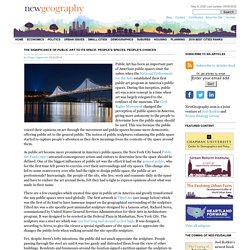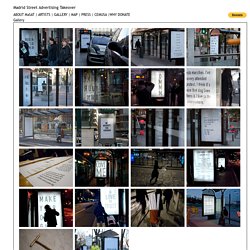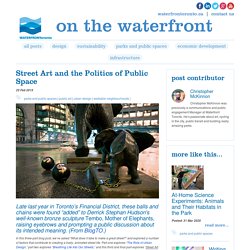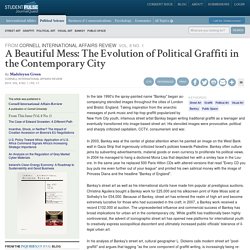

Public art. Five Reasons Why Public Art Matters. Public art matters to me because I see it as a platform for civic dialogue and as the most democratic of art forms.

When done well, a public artwork engages citizens in conversation that can vary from understanding historical and cultural backgrounds, to driving attachment to place and social cohesion. Den Haag - Art in public space. Public Art. Amsterdam. Public art. Streetartmuseum. Collaborative, Creative Placemaking: Good Public Art Depends on Good Public Spaces. By Fred Kent and Cynthia Nikitin This article first appeared in Issue 45 of Public Art Review.

“It is difficult to design a space that will not attract people; what is remarkable is how often this has been accomplished.” —William H. (Holly) Whyte During the past two or more decades, communities around the country have fallen victim to the relentless machinations of a group of people with an overdeveloped, overspecialized “creative function,” who see themselves as experts rather than collaborators or service providers. That’s the bad news. "...planners, artists, and architects are no longer afraid to see themselves as resources, facilitators, and collaborators... " We salute this new paradigm, one in which designers actually welcome the opportunity to work with communities to open up places for new interpretations, creating more room for public art—especially in parks, transforming them from ersatz cemeteries and static sculpture gardens into great multi-use public destinations.
Art in public spaces - The Boston Globe. Art in public spaces Art in public spaces enriches our lives in various ways, in many places.

It can send important messages to the community, make people more aware the environment, and let them see it in a different way. The Significance of Public Art to its Space: People’s Spaces, People’s Choices. Public Art has been an important part of American public spaces since the 1960s when the National Endowment for the Arts established their first public art program in America’s public spaces.

During this inception, public art was a new concept in a time when art was largely relegated to the confines of the museum. BRANDALISM - Street Art for A Change. You may have noticed them on the streets of London, Bristol or, more recently, Paris.

Notice what? Those strange ads and billboards that look like normal advertisements but with twisted messages. Where do they come from? Who did them? Why do they do that? If you look for a meaning of Brandalism on the Internet, you will find plenty of different definitions, one such as, ”The deliberate defacement of corporate iconography, generally for purposes of protest, parody, or social commentary”.
Brandalism. Brandalism. Gallery — MaSAT. Madrid Street Advertising Takeover.

Street Art and the Politics of Public Space. 25 Feb 2015 Late last year in Toronto’s Financial District, these balls and chains were found “added” to Derrick Stephan Hudson's well-known bronze sculpture Tembo, Mother of Elephants, raising eyebrows and prompting a public discussion about its intended meaning.

(From BlogTO.) In this three-part blog post, we’ve asked "What does it take to make a great street? " and explored a number of factors that contribute to creating a lively, animated street life. Street Art that changes how we see the World. From cave drawings to urban graffiti, images and words shape the way we perceive the world.

It is adequately established that our environment effects us in fundamental ways, and that visual art literally changes our consciousness when we look at it. If you wander through any city street, or drive on the highway you will see advertising everywhere. Billboards and posters cluttering our visual landscape with messages to buy this or that. What if public space was used to convey a shared idea from within the community instead of a brand that is privately owned by people living outside of the community? People everywhere are reclaiming public space to change dominant corporate, consumer narratives using beautiful and thought-provoking art.
A Beautiful Mess: The Evolution of Political Graffiti in the Contemporary City - JournalQuest. In the late 1990's the spray-painted name "Banksy" began accompanying stenciled images throughout the cities of London and Bristol, England.

Taking inspiration from the anarchic messages of punk music and hip-hop graffiti popularized by New York City youth, infamous street artist Banksy began writing traditional graffiti as a teenager and eventually transitioned into image-based street art. His stenciled images were provocative, political and sharply criticized capitalism, CCTV, consumerism and war. In 2003, Banksy was at the center of global attention when he painted an image on the West Bank wall in Gaza Strip that ingeniously criticized Israel's policies towards Palestine. Banksy often culture jams by subverting advertisements, material goods or even currency to proliferate his political views.
In 2004 he managed to hang a doctored Mona Lisa that depicted her with a smiley face in the Louvre. In his analysis of Banksy's street art, cultural geographer L. Stencils by Crass. History. Street Art Rebellion - Fourculture Magazine. Over the past two years, the beauty and talent that is involved in street art has been a growing interest.

Some of the most gorgeous works are found on walls and sidewalks around the globe. What makes them more impressive is that the artists rely solely on an aerosol can and maybe some specialty caps that are now manufactured to assist in refining details or enhancing shading for these painters. Very recently some of the artists who attracted me are incredibly political in their work. Banksy, Mear One and Shepard Fairey are names some may find familiar. Anarchism and Art: Democracy in the Cracks and on the Margins - Mark Mattern.
Pop art movement in the US (article) Rebellion as an engine of artistic creation in the twentieth century – Artetrama. Until the early twentieth century art through its various currents, is focused on the representation of reality surrounding the artist. Whether they are customs, religious or scenery scenes, it seems that all the pictorial movements have a common goal, the pursuit of beauty. The movements arising from this moment radically break with that idea. Blog - Seven reasons to believe in urban art – Artetrama. Many are the artists throughout history that have made the fine arts evolve into different styles and techniques. Pablo Picasso and Geoges Braque left everyone with their mouths open when they saw the first cubist paintings.
Trastan Tzara and Jean Arp broke up with all art conventionalisms leading to Dadaism. Kazimir Malevich and Piet Mondrian took to the extreme the recovery of the form lost in impressionism and expressionism, giving rise to abstraction. Well, nowadays, we have in front of our eyes many artists going beyond “conventional” art and, with their own ideas and styles, are defining the basis of new artistic movements. Below we will give seven reasons to believe in urban art. 1.
Since Banksy turned from being an unknown graffiti artist pursued by the law to one of the most sought after artists by major collectors, urban art is not a thing about two kids with a couple of spray cans painting on the streets anymore. 2. 'Brandalism' and 'subvertising': what's behind the new rebellion against advertising?
Political advertising boards are increasingly being targetted by 'subvertising' activists. According to the Urban Dictionary, the word ‘subvertising’ refers to the practice of making spoofs or parodies of corporate and political advertisements in order to make a statement Anyone paying close attention to their surroundings in recent weeks may have noticed an upsurge in subvertising campaigns across the UK. First there was the continued and varied targeting of UKIP election campaign billboards, including a bold effort by Bill Drummond who painted one entirely grey. He explains the reasons behind his act of subversion for the Guardian here. Something to do with them being racist was one reason mentioned. Extinction Rebellion urges ad industry to use its power for good.
Environmental activists Extinction Rebellion have turned their fire on the advertising industry in a public letter, encouraging it to use its expertise in manipulating public opinion for good or risk mass public protests against it. Speaking to the Guardian, one of the authors of the letter, which was written by Extinction Rebellion members with decades of experience of the advertising industry, said the group was not “singling out advertising, as we previously disrupted fashion week and are systematically challenging all industries who have the platform, influence and skills to tackle this epoch-defining crisis but are failing to do so in any meaningful way”. “Though our letter is addressed to the boardroom, we ask everyone within the industry to ‘Tell the Truth’ about the climate and ecological emergency,” he continued.
“Advertising has helped promote high-carbon lifestyles and hyper-consumption. However, if we’re to survive, this must change rapidly.” An artist’s rebellion against street advertising - TRT World. Mayor of Grenoble message to Ad-free Cities conference in Bristol. Rebellen tegen reclame gemist? Start met kijken op NPO Start. Om deze website goed te laten werken plaatsen we functionele cookies. We plaatsen analytische cookies om te bepalen welke onderdelen van de website het meest interessant zijn voor bezoekers. Deze cookies gebruiken geen persoonsgegevens. Meer uitleg Waarom cookies? De Nederlandse Publieke Omroep plaatst specifieke cookies om het gebruiksgemak voor bezoekers te vergroten. Hiermee kunnen we de bezochte website zo gebruiksvriendelijke en interessant mogelijk maken voor de bezoeker. Functionele cookies Cookies die er voor zorgen dat deze website naar behoren functioneert De websites van de Nederlandse Publieke Omroep gebruiken cookies om er voor te zorgen dat onze websites naar behoren werken.